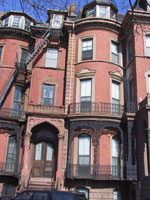|


Even in the North many city theatres and performance
venues were off limits to people of African descent
during the Jim Crow era of the early twentieth century.
Nonetheless, black Bostonians were busy inventing
in finding and creating spaces of their own, among
them private clubs. 
The League of Women for Community Service,
located in a brownstone mansion at 558 Massachusetts
Avenue, is one of the two clubs founded in 1918
that have continued to flourish to this day.
A group of prominent black women, inspired to aid
in the World War I effort, were the founders. Their
number included Josephine St. Pierre Ruffin,
organizer in 1892 of the Women’s Era Club
and its influential newspaper, and her daughter,
“Florida” Ruffin Ridley.
Another active member of the “League”
was Maud Cuney Hare, a black intellectual,
musicologist and founder of a small performing arts
school, who assiduously promoted the cause of artistic
performance and entertainment.
Though born out of a commitment to serve the nation
in the World War I effort, the League (at first
called the Soldier’s Comfort Unit) went on
to work on behalf of community volunteer service.
It also contributed in many ways to support and
sustain intellectual and artistic activity among
black Bostonians. Symbolic of this commitment were
the art exhibits, concerts, literary study groups,
and lectures held at “558” over the
years.
Prominent speakers, both white and black, were regularly
welcomed. The LWCS provided a secure space for black
cultural production and a receptive audience for
performance.
Music, lectures, concerts and drama all had a place
at 558—lifting audiences out of the realm
of daily life, stimulating reflection and fostering
creative activity.
|


